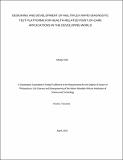| dc.description.abstract | Accurate and timely diagnosis is usually an important step towards appropriate disease management. In resource-limited settings, healthcare workers lack proper facilities to perform vital tests, and the diagnosis of disease is often determined by non-specific, physiological symptoms alone. Simple and rapid tests are needed as pre-requisite tools for patient care and must conform to the criteria set out by the World Health Organization (WHO). Such tests should be affordable, sensitive, specific, user-friendly, robust, equipment-free, and deliverable to the needy, and abbreviated as ASSURED diagnostics. To address the challenge of specific diagnosis for diseases that present with similar symptoms, multiplex diagnostic platforms must be designed. The use of paper has been extensively studied for its potential as matrix for microfluidic devices. In fabrication of multiplexed microfluidic devices, patterning is an important step. Various approaches including cutting, photolithography, wax-printing, plotting and etching have been developed and tested on paper. In recent years, the focus has also been directed towards exploring the potential of hydrophilic threads as a convenient and low-cost approach for fabrication of microfluidic channels and as signal substrate. This research was aimed at designing multiplex diagnostic test platforms that could be used at point-of-care especially in resource-limited settings. The first approach was to design multiplex paper-based platforms where paper was patterned using a combination of cutting and wax-printing. In the second approach, ordinary thread was used to create microfluidic channels and paper discs were used for sample loading, reagent storage and results display to develop a colorimetric test platform that was demonstrated using glucose, uric acid and bovine serum albumin. In the third design, thread was used in combination with nitrocellulose membrane to develop an immunochromatographic test platform for infectious diseases diagnosis and was tested using Helicobacter pylori (bacteria), Hepatitis B surface antigen (viral antigen), and Immunoglobulin G (antibody). Thread-based designs were evaluated for short-term viability under normal storage conditions. All designs produced rapid results with the lowest limit of detection for antigens being as low as 30 ng/ml for immunochromatographic tests. Treatment of hydrophobic threads improved their wicking, with mercerization being the most efficient with wicking rate up to 42 cm/minute. Reagents, including enzymes and antibodies were found to remain viable in dried form on membranes and paper discs. Developing multiplexed paper- and thread-based diagnostic platforms offers a potential approach in developing ASSURED diagnostics to address health challenges in resource-limited settings. Efforts should be directed towards transforming the proposed designs into viable products that can be used at point-of-care. | en_US |

